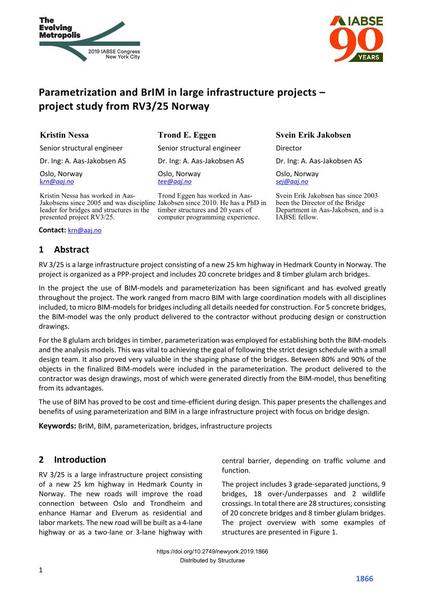Parametrization and BrIM in large infrastructure projects – project study from RV3/25 Norway

|
|
|||||||||||
Bibliographic Details
| Author(s): |
Kristin Nessa
(A. Aas-Jakobsen AS)
Trond E. Eggen (A. Aas-Jakobsen AS) Svein Erik Jakobsen (A. Aas-Jakobsen AS) |
||||
|---|---|---|---|---|---|
| Medium: | conference paper | ||||
| Language(s): | English | ||||
| Conference: | IABSE Congress: The Evolving Metropolis, New York, NY, USA, 4-6 September 2019 | ||||
| Published in: | The Evolving Metropolis | ||||
|
|||||
| Page(s): | 1866-1872 | ||||
| Total no. of pages: | 7 | ||||
| DOI: | 10.2749/newyork.2019.1866 | ||||
| Abstract: |
RV 3/25 is a large infrastructure project consisting of a new 25 km highway in Hedmark County in Norway. The project is organized as a PPP-project and includes 20 concrete bridges and 8 timber glulam arch bridges. In the project the use of BIM-models and parameterization has been significant and has evolved greatly throughout the project. The work ranged from macro BIM with large coordination models with all disciplines included, to micro BIM-models for bridges including all details needed for construction. For 5 concrete bridges, the BIM-model was the only product delivered to the contractor without producing design or construction drawings. For the 8 glulam arch bridges in timber, parameterization was employed for establishing both the BIM-models and the analysis models. This was vital to achieving the goal of following the strict design schedule with a small design team. It also proved very valuable in the shaping phase of the bridges. Between 80% and 90% of the objects in the finalized BIM-models were included in the parameterization. The product delivered to the contractor was design drawings, most of which were generated directly from the BIM-model, thus benefiting from its advantages. The use of BIM has proved to be cost and time-efficient during design. This paper presents the challenges and benefits of using parameterization and BIM in a large infrastructure project with focus on bridge design. |
||||
| Keywords: |
bridges BIM parameterization BrIM infrastructure projects
|
||||
